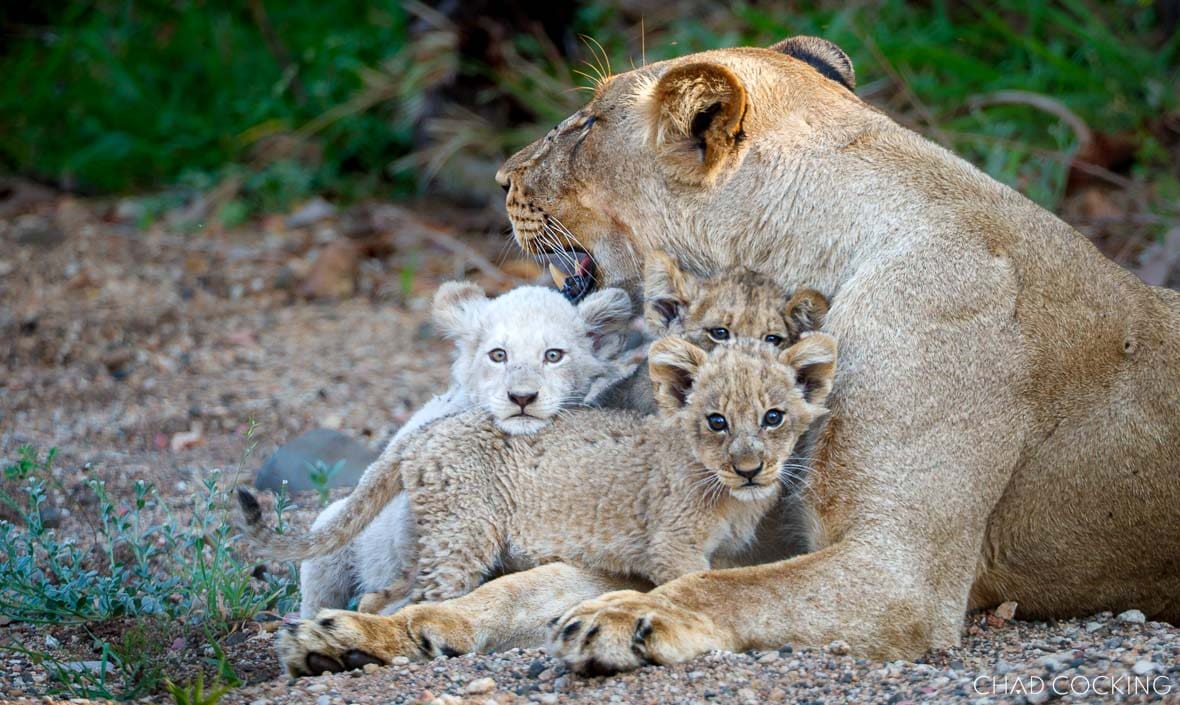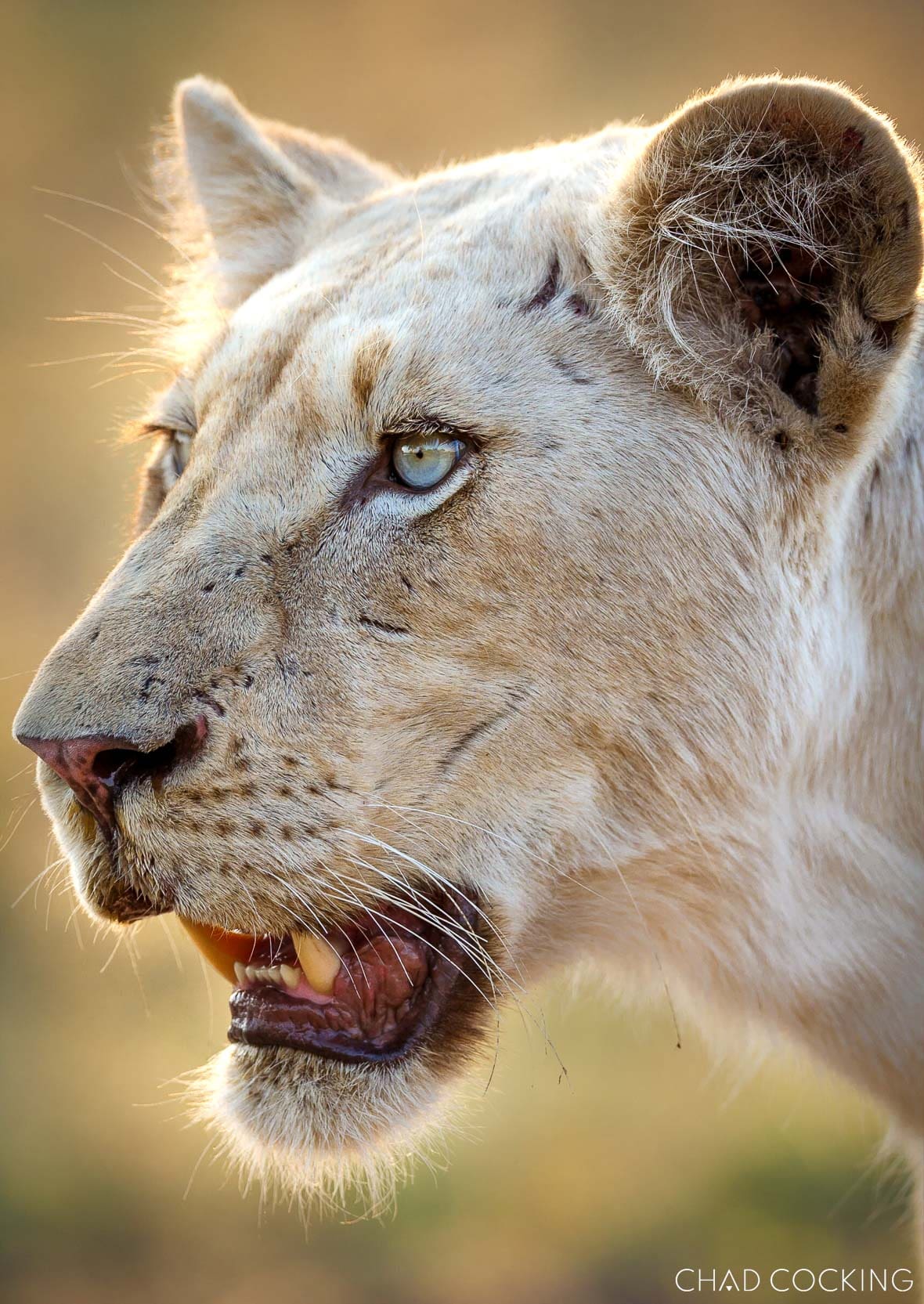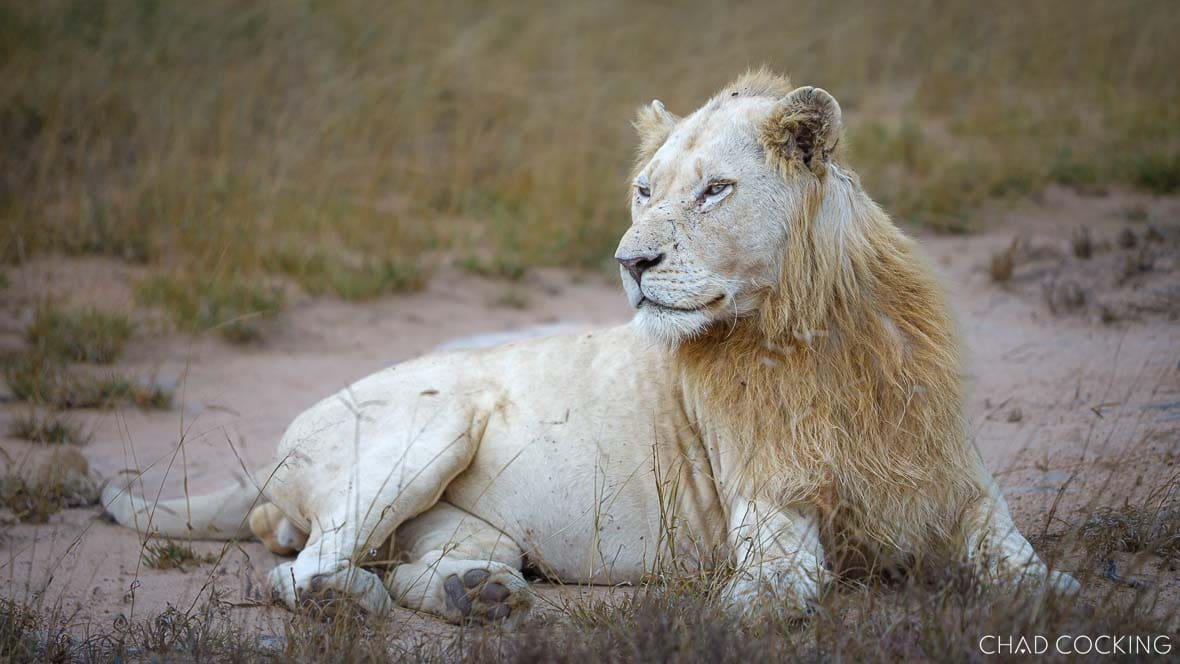This is not a myth. This is nature, in all her unexpected wonder.
White lions have captured imaginations for decades, but did you know their origins trace back to the very heart of the Timbavati? In this beautifully told story from Chad, we explore the rare genetics behind these ghost-like cats, their historic connection to the land around Tanda Tula, and why you just might be lucky enough to spot one on safari.
“So, do you have white lions here?” This is a line I have heard countless times from guests visiting Tanda Tula Safari Camp over the years, and it is a very valid question. After all, the Timbavati ended up on the map in the mid-70s due to their “discovery” in the heart of the reserve when one of the land owners, Chris McBride, found two tiny, pure white cubs poking their heads out from behind their normally-coloured, tawny mother. He had witnessed their conception some months earlier when their father – also a normal, tawny lion – had been mating with the mother. As Chris was studying this pride for his Master’s degree, he was paying close attention to when the female was due to give birth, and when the cubs were expected to come out of hiding – but nothing he had observed had prepared him for the sight that greeted him one fateful morning. Truth be told, Chris had been sick in bed until his sister found the lions on a drive on their family farm, Vlakgezicht – the property adjoining Tanda Tula’s concession to the south – and she raced back to get Chris out of bed. I can only imagine he was glad he complied!

Legacy of the Giraffe Pride – White Lion Cubs.
What Chris realised almost immediately was that these lions were not albinos. Rather than having translucent eyes, their eyes were the same golden colour as their parents. Yet their bodies told a different story. They looked like ghosts – a whiteness that stood out from the surroundings in a way that wouldn’t suggest they would be able to survive very well without the camouflage that had coated their ancestors for as long as the lion’s lineage dated back. How would the cubs remain hidden from danger – a worrying concern, especially given that even tawny-coloured cubs have such low survival rates. If Lady Luck was on their side, and they survived their vulnerable first year, how would they become successful hunters when they stuck out like a sore thumb? While these concerns led to these first-ever recorded white lions being taken into captivity, subsequent litters in the late 1970s and 1980s were allowed to lead a natural existence, and proved all sceptics wrong – they survived just fine with their white coats, and probably led a much cooler existence too!

The Next Generation – Timbavati Pride Cubs.
As researchers have now discovered, their whiteness comes from being born with a recessive gene that needs to be carried by both their tawny mother and father; this gene is a mutation of the tyrosinase enzyme that causes a reduced production of melanin (the dark pigment responsible for colouring eyes, skin and hair). Lions that carry this recessive gene have a decreased deposition of this pigment along the shafts of their fur, rendering them almost colourless. This makes it clear that they are not a separate species, but rather a product of chance.
From limited-scale studies conducted within the Timbavati, some 19 percent of the lions (mostly lionesses) sampled carried the recessive gene. The chances of these recessive genes finding one another in a massive open system and producing a white cub are low. Young Timbavati male lions born as carriers of the white lion gene will disperse into other regions of the Greater Kruger system, and male lions without the gene move into the Timbavati to take over gene-carrying prides in this region. As a result, many of the prides in the Timbavati carry the gene – including those around Tanda Tula – but it is often the males dominating these prides that do not carry the gene; no matter how much mating takes place, no white cubs will be born. However, as this all comes down to genetics, it means that the white gene can lie dormant within a population, allowing the recessive gene to pass from one generation to the next without showing itself. Given enough time, two white gene-carrying lions will find one another and mate (although even this only has a 25 percent chance of the two recessive genes pairing up), and more white lions will be born.

White lioness – Xakubasa Pride.
This may be a convoluted answer to the question of whether you will see a white lion at Tanda Tula, but that is what makes safaris so insatiably addictive – you just never know!
There are presently two white lions in the Birmingham Pride that have been seen in our concession in recent years, but they are quite settled in the adjacent Kruger National Park.
One of the white males born to that pride in late 2018 moved through Tanda Tula in 2023, but he and his brothers never settled, as there were too many competing coalitions back then. He has now settled in the Umbabat, just north of the Timbavati, where he has sired two white cubs with a pride in the area, and they have been known to make use of the Timbavati (which makes sense – they’re known as the Timbavati Pride!).
As recently as July, the white male was reported in the northern reaches of our concession – so seeing him remains a possibility.

Seen roaming through Tanda Tula in 2023, this Birmingham white male later settled in the Umbabat where he fathered more white cubs.
While none of our resident prides have white lions at this present moment, we never know when this will change, as at least some of the females will be gene carriers. The Mayambula Pride sired several offspring to the Mbiri males. These males have had white cubs with two prides in recent years, so we can be hopeful that they left their genetic mark with the lionesses of the pride. I also have my suspicions that the Mayambula Pride shares a genetic ancestry with the Machaton Pride – the original white lion pride from 50 years ago; they still utilise the same geographic area as the Machaton Pride. While we have no idea if the Vuyela males are gene-carriers, we are always hopeful that hidden somewhere on the banks of the Machaton Riverbed might be the next white bundle of joy.
While they have no history of producing white cubs, the River Pride has always had light-coloured lions amongst them since their time at Tanda Tula, including one individual that, in 2023, caused one of the guides to mistakenly identify it as a white cub. Sadly, the error of the observation was soon realised (and corrected), but we remain hopeful.

One of the two Xakubasa lionesses – the first white lions to survive to adulthood in almost decades.
A more hopeful case for white lions can be found with the Giraffe Pride. This pride was the last resident pride to have white lions – at its peak in 2013, they numbered five. The last of these passed away in 2017. The genes, however, remain in the pride. What makes this exciting is the fact that the pride is dominated by five Birmingham Breakaway males. For those with short memories, Birmingham Pride has been shown to be the region’s most prolific producer of white lions of late. While there is no guarantee that these males carry the white gene, there is a good chance that at least one of them does. And if that is the case, with nine lionesses that will hopefully be producing cubs over the coming year, you can be sure that we will be keeping our fingers very tightly crossed that one of them will produce the next white generation of the Timbavati.
When I began working in the Timbavati in 2007, I didn’t even dream of seeing a white lion, as they had been absent for so many years. I am thus extremely grateful that I have been fortunate enough to see ten different white individuals. I now eagerly await the moment when I get to see number 11. And who knows, maybe you could be lucky enough to be with me when I do!
Until next time, cheers!
Chad




